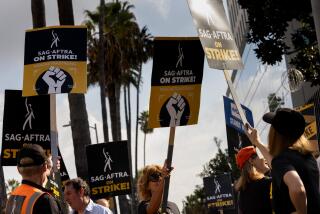The WGA already lost Round 1
As the WGA strike stretches into its third week, I am reminded of the last big labor scuffle the Writer’s Guild of America presided over. Not the 1988 strike that lasted five months and ended largely in failure. No, I mean the ill-fated 2006 strike by the writers of “America’s Next Top Model.”
As early as 2004, the WGA was looking at ways to get writers working in the exploding genre of reality TV under their union umbrella before the big 2007 negotiations began. The guild named a new director of organizing, David Young, in 2004, and in 2005, it elected a new president, Patric Verrone, whose whole platform revolved around adding to ranks of the guild. Their intentions were more strategic than altruistic: Without reality programs to fall back on, the TV networks would be hit harder and faster by any strike. It would have been a fine strategy, had it worked.
A small WGA group called the Reality Organizing Committee debated strategies. On one point they all agreed: You couldn’t organize reality TV writers one show at a time. The writers would have to demand guild representation en masse at all the networks.
Those of us actually working in reality TV, however, knew little of these plans. Back then, I was one of the 12 story editors on the CW’s “America’s Next Top Model,” where none of us got medical benefits, let alone residuals. Still, I was far more concerned with doing my job well and making ends meet on my entry-level salary than making waves.
But after nearly two years of meetings, the WGA’s reality committee was still far from a cohesive plan, so the guild leadership settled on a more expedient strategy: They would choose one popular show to be the poster child for the plight of reality TV writers. They chose “America’s Next Top Model.”
In the early summer of 2006, only one of the “Top Model” writers was involved in the union campaign. The rest of us were, at best, tangentially aware of its existence. Until, that is, the afternoon of June 21. That was the date of our first official meeting with WGA organizers. Over lunch at a Tex-Mex restaurant in Santa Monica, they spelled out the manifold benefits of guild representation: health insurance, pension contributions and credits for our work. The industry was ready for reality story editors to enter the WGA, they said. Les Moonves -- head of CBS, which owned the new CW network -- had been “put on notice.” There was no talk of losing our jobs. We believed the guild’s ambiguous promise, “you’ll come out of this better than you went in.”
Why only “Top Model?” one co-worker asked. Why not all reality shows? “‘Big Brother’ is ready to go out,” they told us. “So is ‘The Amazing Race.’ But you need to start the ball rolling.” We would be the vanguard. Our fellow reality scribes would take to the street inspired by our courage, they said. They bought us lunch.
Over the next month, we asked as many questions as we could: Why couldn’t we wear red T-shirts or “Working without a WGA contract” buttons to the office? Couldn’t we start by insisting that the company pay us overtime? Why couldn’t we let our petition to unionize work its way through the National Labor Relations Board, the government bureaucracy that decides who gets to form a collective bargaining unit? We were told, in no uncertain terms: Stick to the plan. In 2006, as it was this year, the WGA leadership was clamoring for a strike.
The night before the strike began, after a long, tense meeting at the guild offices, we were taken into a conference room where the Reality Organizing Committee gave us a standing ovation for our bravery. The moment played out as great theater, but it was as meaningless as it was absurd. In fact, most of the committee members were hearing about the “Top Model” strike for the first time, as it effectively ended their deliberative, years-long efforts. More odd, it was the first time most of the “Top Model” writers had ever heard of the Reality Organizing Committee.
The next morning, July 20, in front of our production offices in West Los Angeles, I read our statement to about 100 supporters and the news crews, officially launching our strike. We hoisted our WGA strike signs and never entered those offices again. In the weeks to come, our supporters would dwindle, then disappear.
The last week of September, we all received letters notifying us that our jobs had been eliminated, the entire story department abolished. The guild had vanished from our cause, and the International Alliance of Theatrical Stage Employees, which represents the video editors, swooped in to unionize the show, freezing the WGA out of “Top Model” for good.
There were 12 of us, not 12,000. And so the strike against “America’s Next Top Model” has become a footnote in the long struggle for writers to assert power in an industry that seeks to keep us powerless.
I want the WGA to prevail in the current standoff, and I believe the writers deserve everything they are asking for. But if the negotiations starting next Monday yield nothing, I fear that the strike may drag on for months, and the writers may come to understand the importance of the Forgotten Strike a year and a half too late.
The WGA has made a critical error in underestimating the importance of reality TV. Take out sports and news, and about a quarter of shows on network prime time this fall are “unscripted,” which is to say, their writers are not members of the WGA. If this strike drags into 2008, the networks are sure to plug their schedules with hours more of such cheap, easy-to-produce programs with words like “Dancing” and “Next Top” in the title.
No one from the WGA was communicating that to the full guild in the summer of ‘06, leaving some members horrified that the WGA was ready to let lowly reality types into their club, and the rest unaware that the “Top Model” strike was going on at all. And then when it failed, there was no Plan B.
Had the WGA fulfilled Young’s initial promise to procure guild status for all writers working on reality, animation and nonfiction shows, the networks would shortly have nothing new on the air at all. As it stands, the WGA has pushed its members to walk out on their own jobs, and it has left the networks with powerful leverage -- the ability to keep making new TV content.
On Oct. 23 of this year, with talks stalled between the WGA and the Alliance of Motion Picture and Television Producers, Variety published an article summed up by this headline: “WGA gives up on nonscripted effort.” Organizing reality TV writers was one of the contract demands that the WGA was willing to toss aside to reach a deal before the Nov. 1 strike deadline, the article reported.
The next day, an e-mail with the expected rebuttal arrived from the WGA president. The guild’s reality TV efforts were as strong as ever, he said. But as far as I could tell, the only error in the Variety article was that it hadn’t been published a year earlier.
More to Read
The biggest entertainment stories
Get our big stories about Hollywood, film, television, music, arts, culture and more right in your inbox as soon as they publish.
You may occasionally receive promotional content from the Los Angeles Times.










